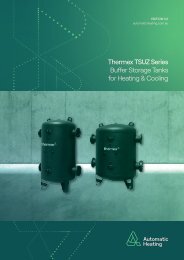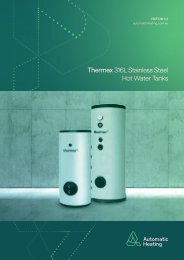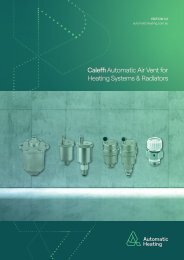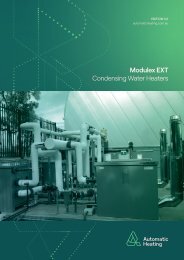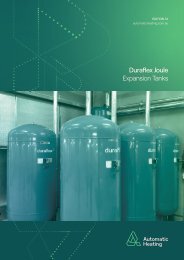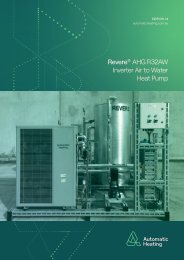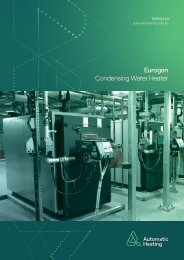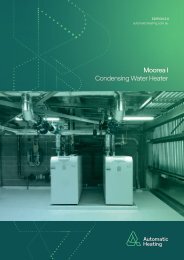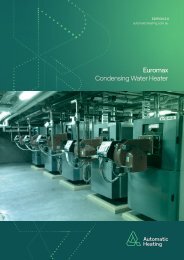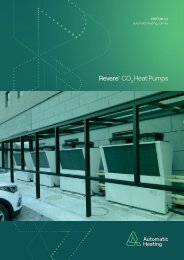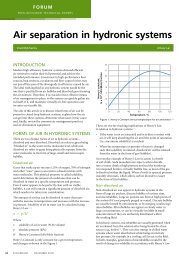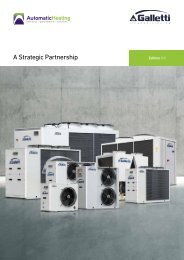AHG Solutions Guide_Edition 2.7
Full Product and Solutions Guide - Automatic Heating Global Pty Ltd
Full Product and Solutions Guide - Automatic Heating Global Pty Ltd
You also want an ePaper? Increase the reach of your titles
YUMPU automatically turns print PDFs into web optimized ePapers that Google loves.
Expansion Tanks & Pressurisation Systems<br />
Contents<br />
Introduction to Expansion Tanks<br />
& Pressurisation Systems<br />
EXPANSION &<br />
DEAERATION<br />
Why do we need<br />
Expansion tanks?<br />
Expansion Tanks & Pressurisation systems are critical to<br />
the successful operation of heating and cooling circuits and<br />
must essentially fulfil three fundamental tasks:<br />
• Maintaining the pressure within permissible limits at<br />
every point of the system, that is, the permissible working<br />
pressure must not be exceeded as well as maintaining<br />
a minimum pressure to prevent vacuum, cavitation and<br />
evaporation of the system liquid, e.g. in circuits with<br />
superheated water, solar systems.<br />
• To prevent a negative pressure at the highest points of the<br />
installation in order to avoid the intrusion of air into the<br />
piping network.<br />
• Compensation of volume fluctuations of the heating or<br />
cooling water due to temperature fluctuations.<br />
• Providing a water seal to prevent system-related water<br />
losses.<br />
With any heating or chilled water system there is expansion<br />
and contraction as the system water is heated or cooled.<br />
Because water is incompressible, the pressure in the<br />
system will increase or decrease accordingly. To prevent<br />
damage to the system components, expansion tanks are<br />
installed which contains the excess volume as the water<br />
heats and expands and allow that water to fill the vacuum<br />
created when the system water cools and contracts.<br />
Careful calculation, commissioning and maintenance are<br />
the prerequisite for the correct functioning of the overall<br />
system.<br />
Expansion tanks in open vs.<br />
closed systems<br />
Open header or feed tanks were an early form of<br />
expansion tank which were usually copper lined open<br />
tanks installed above the highest point of the system as<br />
the tanks relied on gravity to maintain system pressure.<br />
Apart from the connection to the system, the tanks<br />
were fitted an overflow outlet and a mains water inlet<br />
controlled by a floating ball valve which allowed the<br />
system water to be replenished automatically if needed.<br />
While functional, open header tanks fail to provide<br />
an optimal solution to the expansion problem due to<br />
several key issues.<br />
• Because the tanks are unsealed, the system water is<br />
constantly exposed to the air which allows the system<br />
water to absorb oxygen. Oxygen in the system leads to<br />
corrosion and decreased pump efficiency.<br />
• Depending on the design of the tank, there may be the<br />
potential for backflow if the water level rises above<br />
the mains inlet, leading to contamination of the water<br />
supply.<br />
• With any open tank, there is the potential for overflow<br />
which is normally piped to the nearest drain. Given that<br />
the tank needs to be elevated, if the drain becomes<br />
blocked or the tank leaks, the resulting spillage may<br />
cause damage to surrounding building surfaces.<br />
• Because the system is open, system pressure is limited<br />
to the head pressure achieved by the height of the<br />
tank. This may negatively impact pump performance<br />
due to insufficient NPSH (Net Positive Suction Head),<br />
potentially resulting in cavitation and pump failure.<br />
• Many modern boilers require controlled system<br />
pressures and water quality and are therefore not<br />
suited to open vented systems.<br />
To overcome these issues, most heating and cooling<br />
systems are now designed as closed systems which<br />
allows system pressure to be controlled and gases<br />
to be eliminated, resulting in greater efficiencies and<br />
improved performance across all components of the<br />
system.<br />
166



